2023 PortSide year-end report
/Recap of PortSide’s 2023 impact on public policy, education, and historic preservation! And the year’s not over! There are December milestones and news in here!
Read MoreNYC needs more #piers4boats! PortSide’s blog covers our WaterStories programs, urban waterways issues, the BLUEspace, development plans for the NYC waterfront, our ship MARY A. WHALEN, other historic vessels, and boats and ships of all sizes.
Recap of PortSide’s 2023 impact on public policy, education, and historic preservation! And the year’s not over! There are December milestones and news in here!
Read More2016 year in photos at PortSide NewYork!
Read MoreOn the occasion of the 4th anniversary of Sandy, PortSide NewYork launches Red Hook WaterStories. This is a digital museum with significant resiliency information. The site covers 400+ years of Red Hook waterfront history - NYC’s maritime story in microcosm - and reveals forgotten and overlooked stories from this evocative neighborhood.
Read MoreA water-themed history trail about and for fascinating Red Hook, Brooklyn. It will educate visitors and locals, help revitalize Red Hook and help protect this community from floods. It tells NYC's maritime story in microcosm. This year, we are launching a pilot multimedia map and creating a hard copy visitor guide and signs with QR codes around the neighborhood that alert people to the website. We will create large, outdoor, exhibit panels with this content. We are taping more oral histories to share.
PortSide offices aboard the ship MARY A. WHALEN are a buzz as we push ahead with Red Hook WaterStories. Many new consultants and interns have come aboard to help develop and catalog content. The accessibility of our new home is allowing people with valuable skills, but no prior relationship to PortSide, to literally step (or ride their bicycle like David Levine) up to the pier and get involved.
We thank Councilman Carlos Menchaca both for seeing the importance of our new home and for the $20,000 in funding that is pushing the project forward. We have applied for other funding, and have launched a campaign to raise another $20,000 by then end of June 2016.
Our Curator and Historian Peter Rothenberg has been joined by a team of consultants, advisors and interns. Some are interviewing, some research archives, some are deep in the html end of the archive. Bios of the team on the Red Hook WaterStories webpage.
We have been collecting new content and looking backward, meaning we sought technology and advice on how to get our archive coded and organized. David Levine has 25 years experience in content management at major corporations and is leading the tech end of the project, selecting the software for content management and website creation. Lots of conversations between him, Peter and new advisors Johnathan Thayer and Marilyn Oliva helped selected us Omeka as the archivist software to use. The first version of the multimedia RHWS website may be Omeka itself. Much to learn and code in all this!
Johnathan Thayer teaches archival practice and preservation at Queens College and is the Senior Archivist at Seaman’s Church Institute, founded in 1834 which has thousands of items and oral histories in its collection. Despite all that content, they have nothing about Red Hook in their files – proof that PortSide’s project has something to contribute.
Regina Carra, a graduate student at CUNY Queens College studying Library Science and History, learned about RHWS from Johnathan and was so excited by the project that she rejiggered her schedule to work with us one day a week.
We have had long meetings and brainstorming sessions around the galley table to discuss what themes, issues and peoples to include so we know to look for such content and have the archive coded in advance to be ready to receive that kind of content. “War” and “”military,” how are they the same or different? With our focus on immigrants who arrived by water or worked on the waterfront, what do we do about the “non-ethnics,” the English or WASPS? How do we deal with false history (the errors so often repeated in the era of Google)?
Do we include a layer that explains sources so people can see that many a map or engraving that has been used to show “this was Red Hook” is an illustration of a plan, an intention, and did not yet exist? That kind of discussion is so pertinent to the resiliency (flood prep) aspect to Red Hook WaterStories.
As a water-aware organization, we planned to talk about underground water issues since we started this work in 2005. After superstorm Sandy, information about the historic filling of creeks, swamp and shoreline is very timely. It's key to understand that so many historic maps of Red Hook show a street grid of intentions over “land” that remained water and swamp into the 1900s. On a lighter note, in honor of our ship cat Chiclet and her devoted followers, we decided to add cat WaterStories. History needs to be fun too!
We have a bottomless font of facts and tips about the history in advisor Norman Brouwer, a noted maritime historian and the person who built the South Street Seaport library. He also has a personal collection of thousands of maritime postcards which we hope to access for illustrations.
Julia Golia, Director of Public History at the Brooklyn Historical Society, told us about resources in their archives and was receptive to partnering as they move ahead with their waterfront museum and waterfront history website in partnership with Brooklyn Bridge Park.
Melinda Boros, an immigrant from Romania, brings us a fresh perspective in her role as consultant. Red Hook was one of the first neighborhoods she found after emigrating in 1998. It's abandonment was something she expected in Ceaucescu’s Romania not the USA, so she dove deep into historical research to come to understand it. Barbara Wye, a recent grad in Anthropology and Digital Media Design with experience in community organizing around preservation, is helping with outreach, event planning and graphic design.
Many Red Hook WaterStories involve Spanish speakers, especially since the first point of arrival for Puerto Ricans in NYC was ships docking at Red Hook piers. Intern Ivy Ann Rosado, a senior at Hunter College of Dominican heritage is helping with this research and other aspects of the project.
We are interviewing more people for more video and oral histories. Jenny Kane leads the oral history work. John Weaver handles the video camera. Our President Carolina Salguero, an award-winning photojournalist in her prior career, does some of the interviewing.
If you, or someone you know has some Red Hook WaterStories to share, get in touch! WaterStories include: all things working waterfront (shipbuilding/repair, ports/freight movement, creation of ports/changing shoreline, merchant marine/worked on boats, ferries), emigrated here by ship, worked at waterfront facilities, played/fished/relaxed on the waterfront, waterfront religious rituals, drownings, Sandy experiences, created an art work or piece of literature inspired by the Red Hook waterfront.
This project is supported in part by the New York State Council on the Arts with the support of Governor Andrew M. Cuomo and the New York State Legislature, and funding from NYC Councilman Carlos Menchaca.
REBUILD BY DESIGN PLAN BY HR&A COOPERS ROBERTSON PUTS PARK SPACE ON TOP OF THEIR PROPOSED PROTECTIVE SEAWALL.
By Carolina Salguero
This blogpost is a response to Curbed’s 1/28/16 article about Red Hook which carried only parts of several long conversations with Nathan Kensinger. Here is more of what I said so that my position, and PortSide NewYork’s, on changing Red Hook is better rendered.
The Curbed article looks back; my waterfront work, from my photojournalism to founding the forward-looking non-profit PortSide, focuses on the growing maritime sector, making change and shaping the future. At PortSide, we use history to further Red Hook's development. All images, except the rendering above, are copyright Carolina Salguero.
Red Hook has evolved from a place perceived by 1990’s national media as a hopeless crack den to a peninsula that in 2014 was the announced recipient of a "first in the nation" plan for urban flood protection.. Hello IFPS! That is our future, example to the nation.
I understood Est4te Four to be the core of Nathan’s intended story. Thus, I said that, given that Red Hook was going to change, hugely change, it was better that we have Est4te Four, with a curated vision and their standards, than have the building boom of “luxury”’ housing such as occurred on Fourth Avenue in Park Slope/Gowanus. That left us with a hodgepodge of dreadful buildings like the yellow brick one looming over the historic Old Stone House.
Yes, we talked nostalgia. We talked a lot about Red Hook changes and my personal markers for the stages of evolution.
This led me to remark that we all seem to fall in love with the Red Hook of our first contact, and the point of that remark was not to say that my first experience of 1997 (as a visitor, I moved here in 1999) was better or more valid than that of someone arriving in 2002 or the 1980s, but to convey how Red Hook triggers a deep love that is very nostalgia based.
All newcomers to Red Hook love Red Hook, that’s why they come (you don’t come here for the great transportation), and their love starts in, and connects to, the era they arrive.
I said that was one of the great things about my being involved with Red Hook, it has an engaged community that cares about this place.
My view of Red Hook is so NOT nostalgia-driven that I had a lot positive to say about IKEA. IKEA’s Sandy recovery work (done with Swedish modesty that did not tout what they did) was so significant that PortSide honored them for it.
I said the IKEA waterfront esplanade was very well designed, one of the best in the city. I said all that despite saying that closing the graving dock was a policy mistake by the city and a personal loss to me; it was my photographic muse for 5 years. I had unfettered, permitted access to it and could come by land or sea, day or night; and I had the run of the old shipyard too.
The Curbed piece concludes with the quote “"It's not going to be the same Red Hook for a lot of the people who live here now."”’ whereas I talked quite a bit about the people who are likely to stay in Red Hook, the overwhelming majority of Red Hook’s residents, eg the residents of the NYCHA development in the Red Hook Houses East and Red Hook Houses West. I said that for all the problems faced by those folks, they had a large measure of residential stability.
I said that one of my hopes for Red Hook was that, with all the change, wealth and resources coming to the Red Hook around the Houses, more resources would be focused on helping those NYCHA residents. Some of that was visible in the great number of homegrown non-profits on this small peninsula. I said that entrenched, urban poverty was a tough challenge, but that we should try. It is certainly part of PortSide’s mission.
I said that even with all the new people moving in, much stayed the same: Red Hook the close knit community where gossip and rumor are big. Gary Baum, the friend of the pick-up truck sledding mentioned by Nathan, used to joke that if you sneezed, in 10 minutes people know that 7 blocks away.
All of which led me to remark that what I wish Red Hook would get better at research and negotiation since so many of our land use issues were characterized by “did you hear that?!!” shock that was not necessarily based on fact; and that, as a community, we had yet to negotiate benefits from any major real estate development. Segue to NY Rising, a change in that dynamic.
Once Nathan and I got off the nostalgia beat, I spent a lot of time talking about NY Rising, my voice starting to crack with emotion when I talked about how beautiful it was for me to see that the disaster of Sandy had germinated something that augured such good for Red Hook.
NY Rising is a NYS program, and its Red Hook committee members (including me) were appointed by the State to craft a resiliency plan for $3MM in funds the state would provide.
It was a helluva lot of work over some 9 months, but we had the benefits of the region’s best consultants, paid by the state, to support the effort. I said it was a new model worth remembering: government paid to give grassroots community members planning resources (as opposed to Community Boards in gentrifying areas that are overwhelmed by trying to respond to Land Use permits and variances and that are not funded in proportion to that workload. Hint, hint, NYC.)
Official NYS webpage for NY Rising statewide
Official NYS webpage for NY Rising Red Hook committee
Blog of Red Hook’s NY Rising committee
Final resiliency plan of NY Rising Red Hook committee, shorter executive summary and mini brochure version.
Red Hook's NY Rising committee has gone well beyond the State-appointed mission. We proposed programs exceeding that budget. The committee has already sought and secured outside funding to further some projects, including the microgrid. The committee has continued to meet and is becoming a non-profit to further work in Red Hook. It is also looking to expand members. GET INVOLVED! It sought the support of the Municipal Art Society to host the Red Hook Summit about resiliency projects in Red Hook.
COME TO THE RED HOOK SUMMIT! It is Saturday, 1/30/16, 10am – 1pm at Summit Academy, 27 Huntington Street. Full disclosure, I am presenting for PortSide there.
I talked to Nathan about my role on NY Rising where I tried to raise NYCHA issues (I proposed the solar-powered emergency lights in the final plan) and my big focus was activation of the waterfront (the waterways, really) and ensuring that the wisdom of NYC’s 2011 waterfront plan Vision 2020 (embrace and activate the waterways!) was not drowned by Sandy (water is destructive, let’s build walls!).
As a result, I was very moved when at the IFPS (Integrated Flood Protection Study) meeting last week, community members very strongly supported the idea of waterfront access and maritime activation that were on the sheet of NY Rising “values” had the room discuss.
Listening to the IFPS room, with the report-back from each break-out table echoing PortSide values for the waterfront, I felt that I, and PortSide staff and interns, had really made a difference preparing advocacy papers, blogposts, webpages, walk-to-ferry-landings studies, etc for NY Rising, all of which is shared on our website. Our NY Rising work and waterfront vision was embraced by the room without our having spoken up for it in that room. Given that the IFPS is a “first in the nation” program, the eyes of the world are on us in Red Hook, so it was powerful for me to see PortSide’s harbor advocacy work picked up by the IFPS process.
The thrust of Nathan’s Curbed piece is displacement, new replacing the old, but I also talked about what NYC’s real estate driven press (Ahoy, Curbed!) does not cover very much: the growth of the maritime sector. So I rattled off some Red Hook increases in maritime activity since I moved here in 1999: New York Water Taxi (a new company, and headquartered in Red Hook), Vane Brothers tug and barge company expanding two times beyond the footprint of the old Ira S. Bushey yard at the foot of Court Street (where the MARY A. WHALEN started work in 1938) to GBX and Port Authority piers, a new cruise terminal, and Red Hook Container Terminal expanded business (despite hiccups of lawsuits, Sandy and more), and the founding of PortSide NewYork, to create a maritime hub that would foster the community revitalization of Red Hook along a water and maritime theme, combine working waterfront, public access and community development and be a test lab and advocate for expand that model harborwide.
I told Nathan that in September, 2015, PortSide asked the EDC for the space inside the Pier 11 warehouse next to the ship that had been promised to us in 2009, 2010, and 2011 – space that the EDC had also promised to the community as the home for PortSide.
I concluded by sending Nathan two renderings of what PortSide plans for Pier 11, a forward-looking vision for Red Hook. Here is what we are working towards! #GetOnBoard and join us!
2015 was a year of major milestones and growth. See, read and feel it below.
The pivot point was the exhilarating move on May 29 in the video at right.
Our new site strengthens our ability to fulfill the PortSide vision of combining the working waterfront, public access and community development.
Please donate now and support our momentum!
The public access at our new home enables us to grow our educational programs. We hopped on it right away with outreach such as our Open House for Educators Week and researching new curricula. We gained new partners in the World Monuments Fund, the Williamsburgh HS of Architecture and Design (WHSAD), and Behind the Book. We had three summer interns from WHSAD and two college interns from Spain. We created a curriculum for simple machines aboard the MARY A. WHALEN and taught Hurricane Sandy & resiliency to elementary school kids. For adult job training, we furthered our relationship with the painters' union District Council 9.
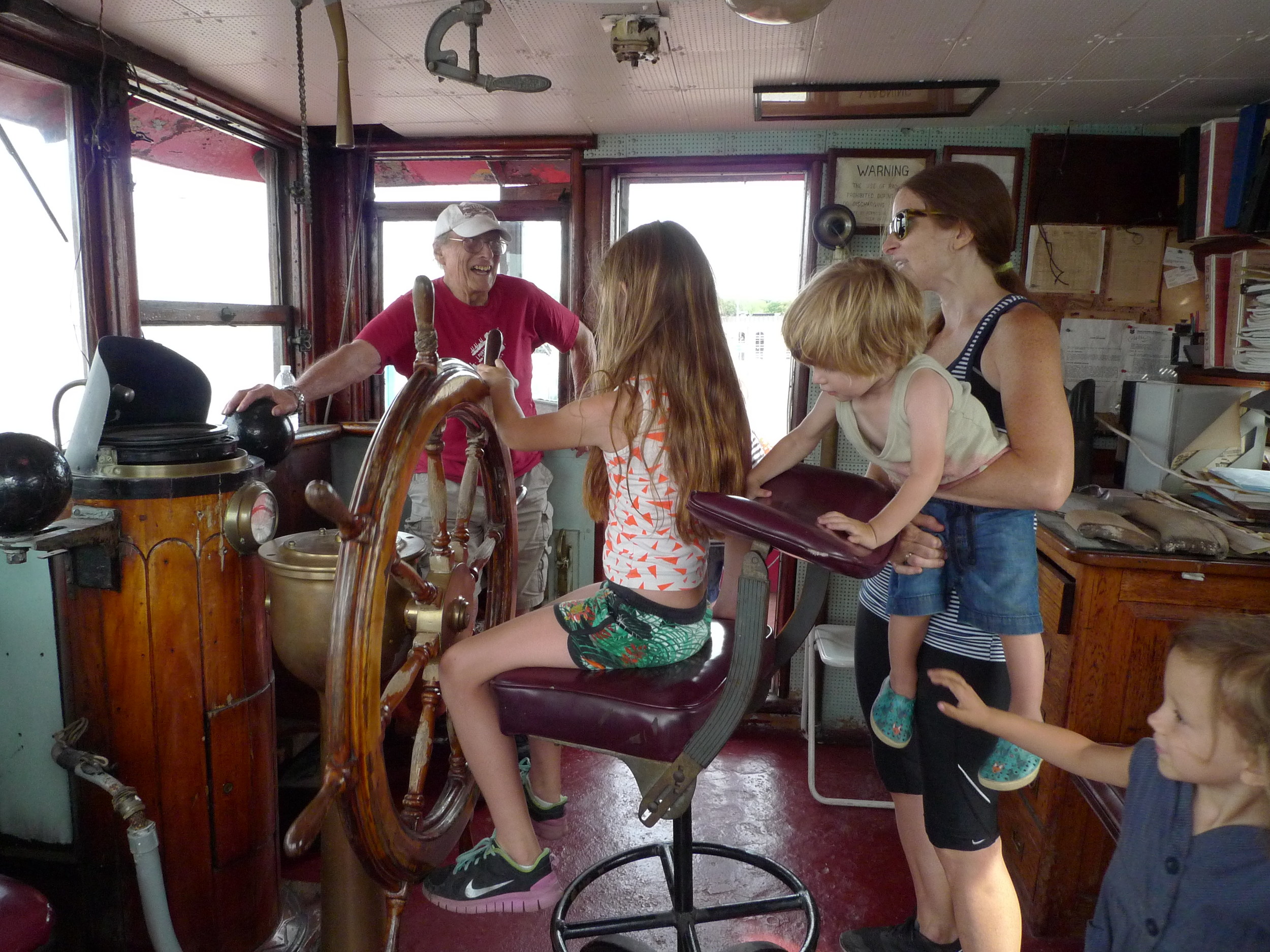
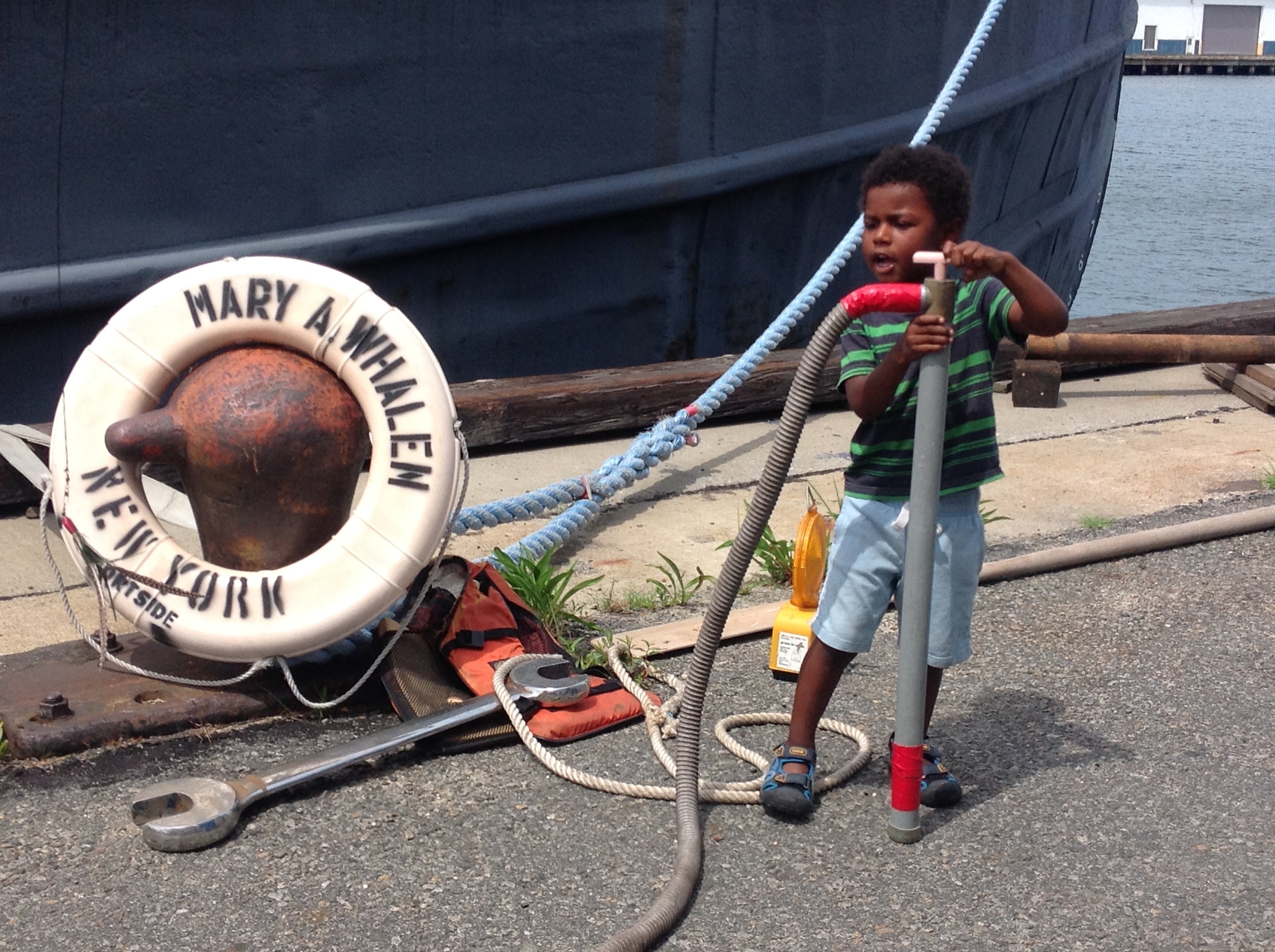
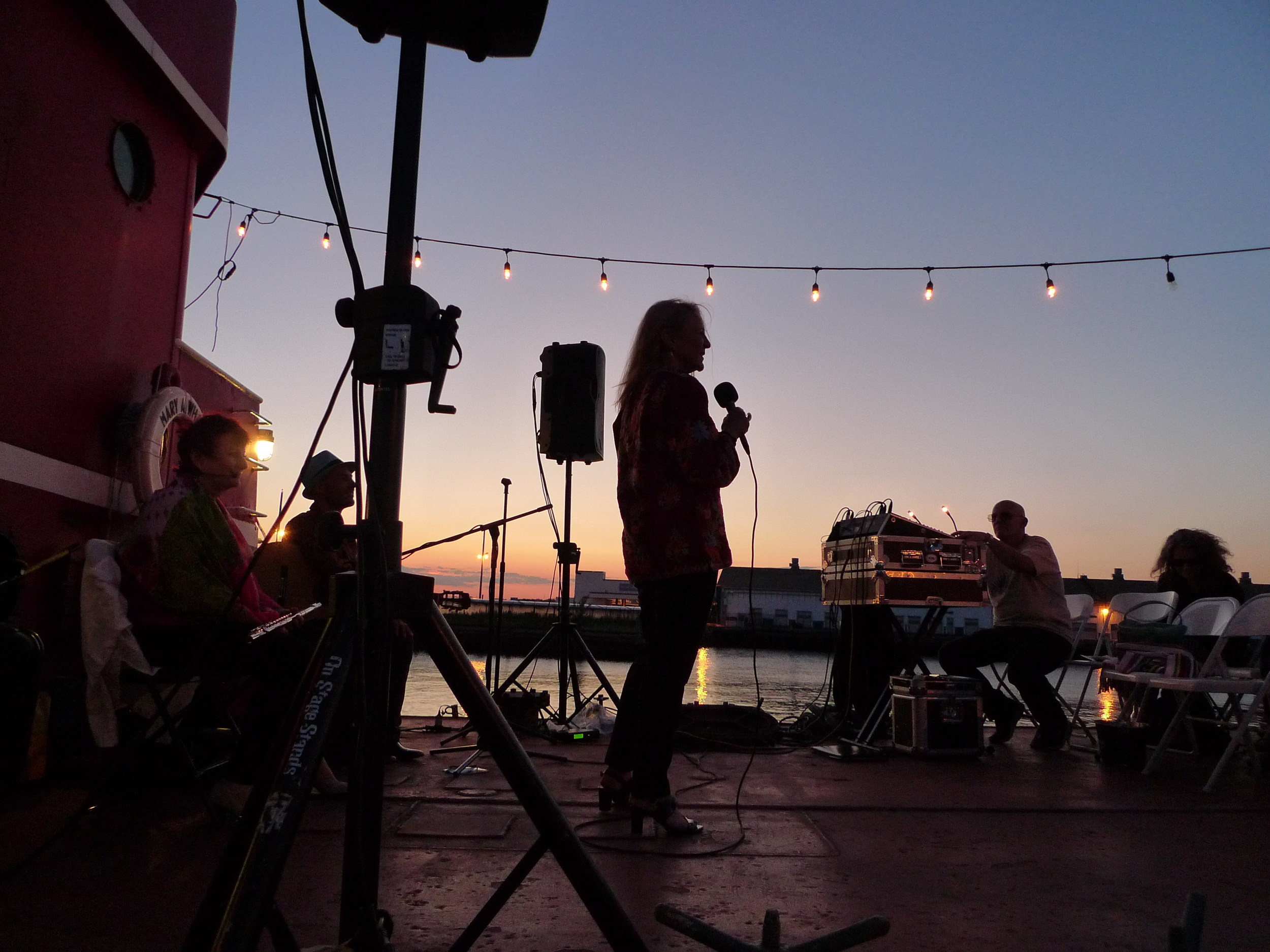
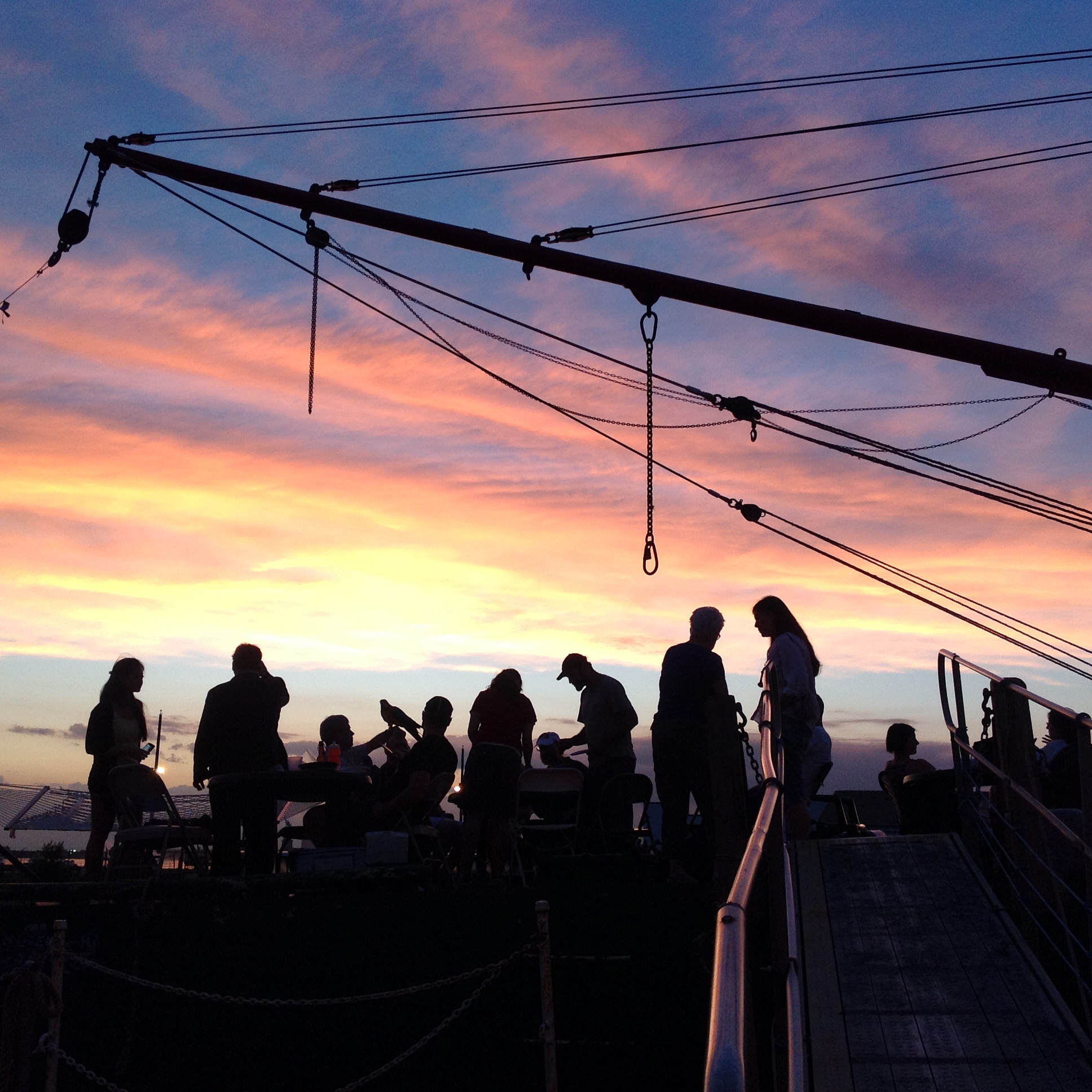
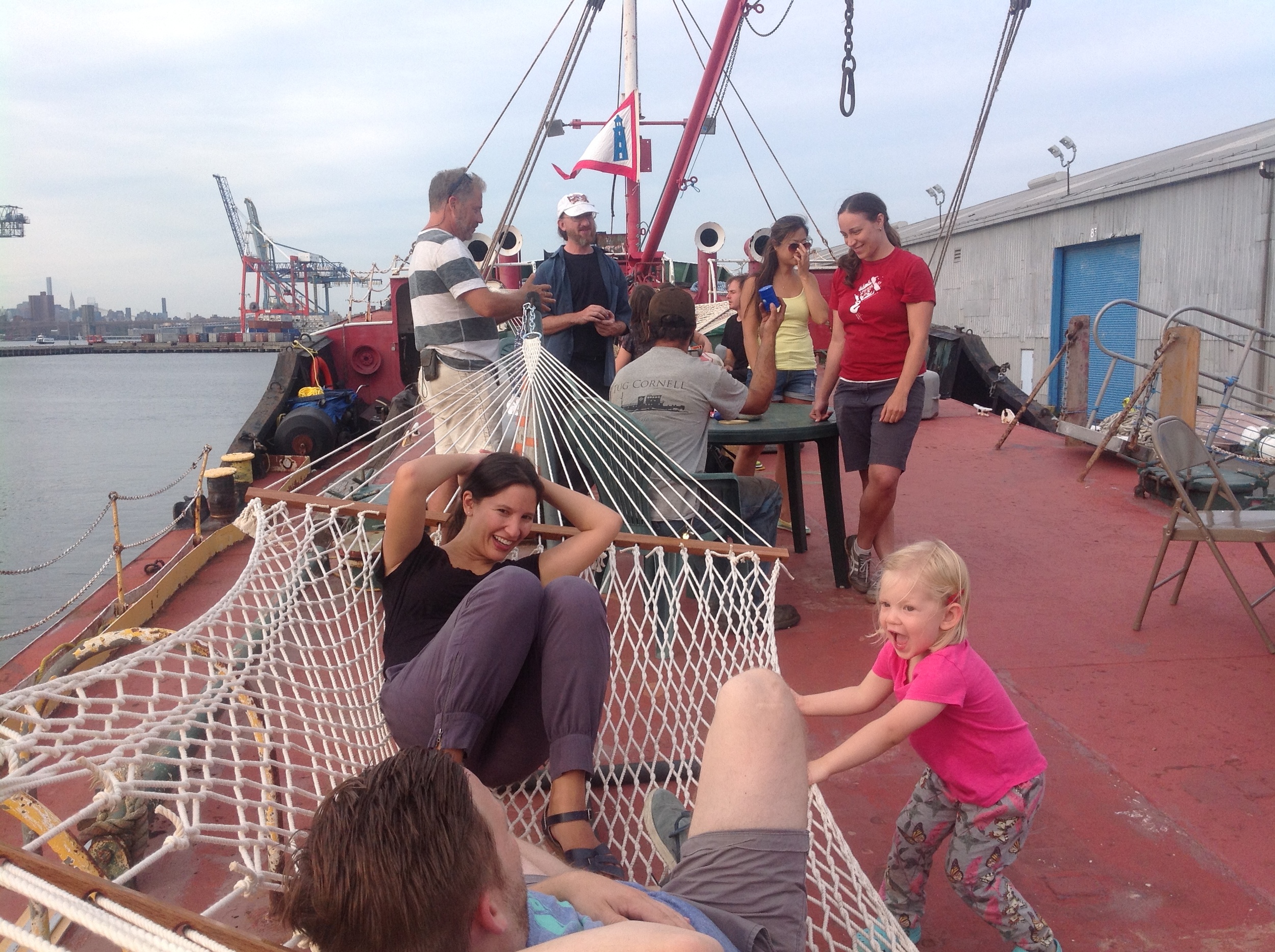
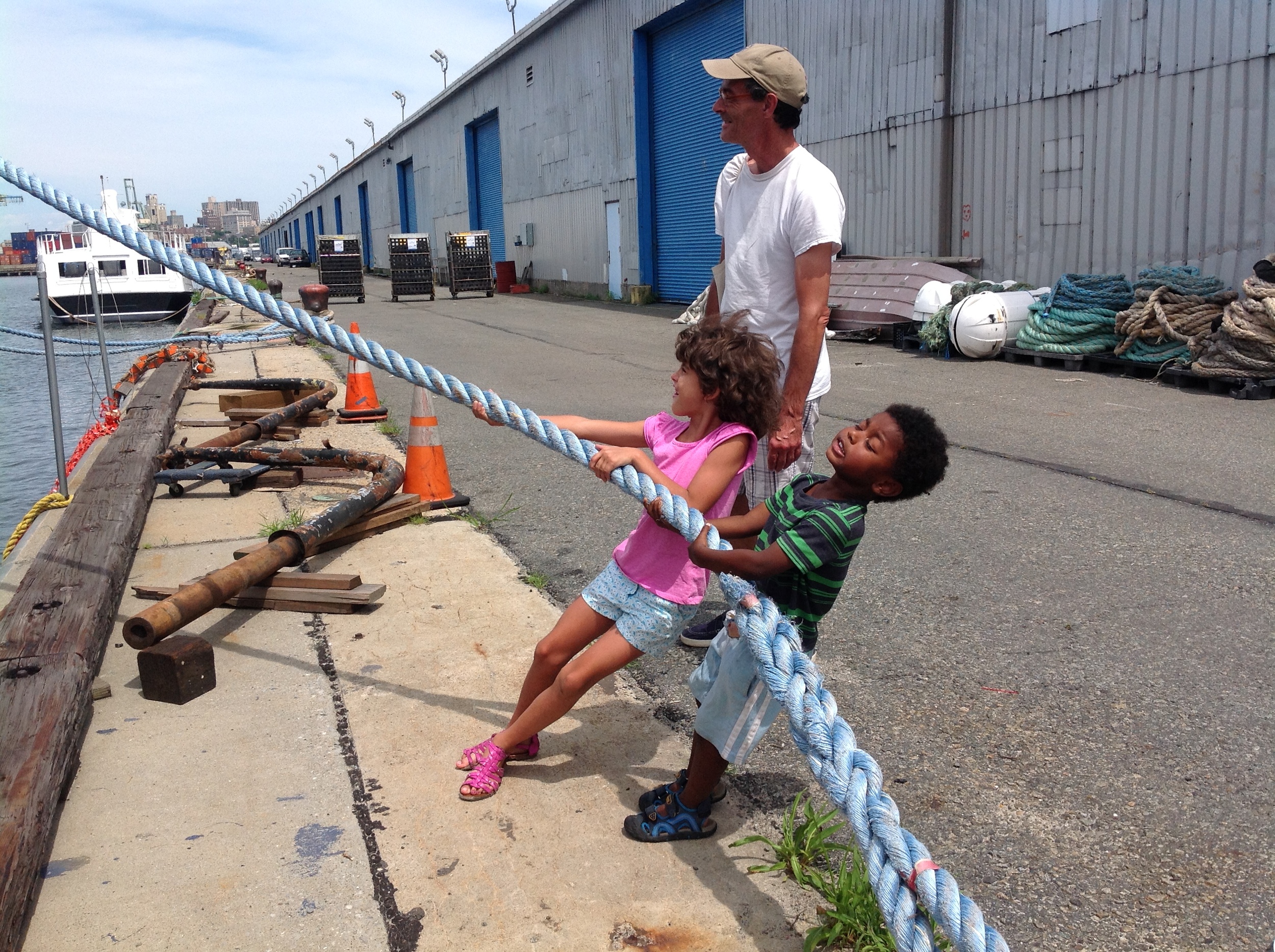
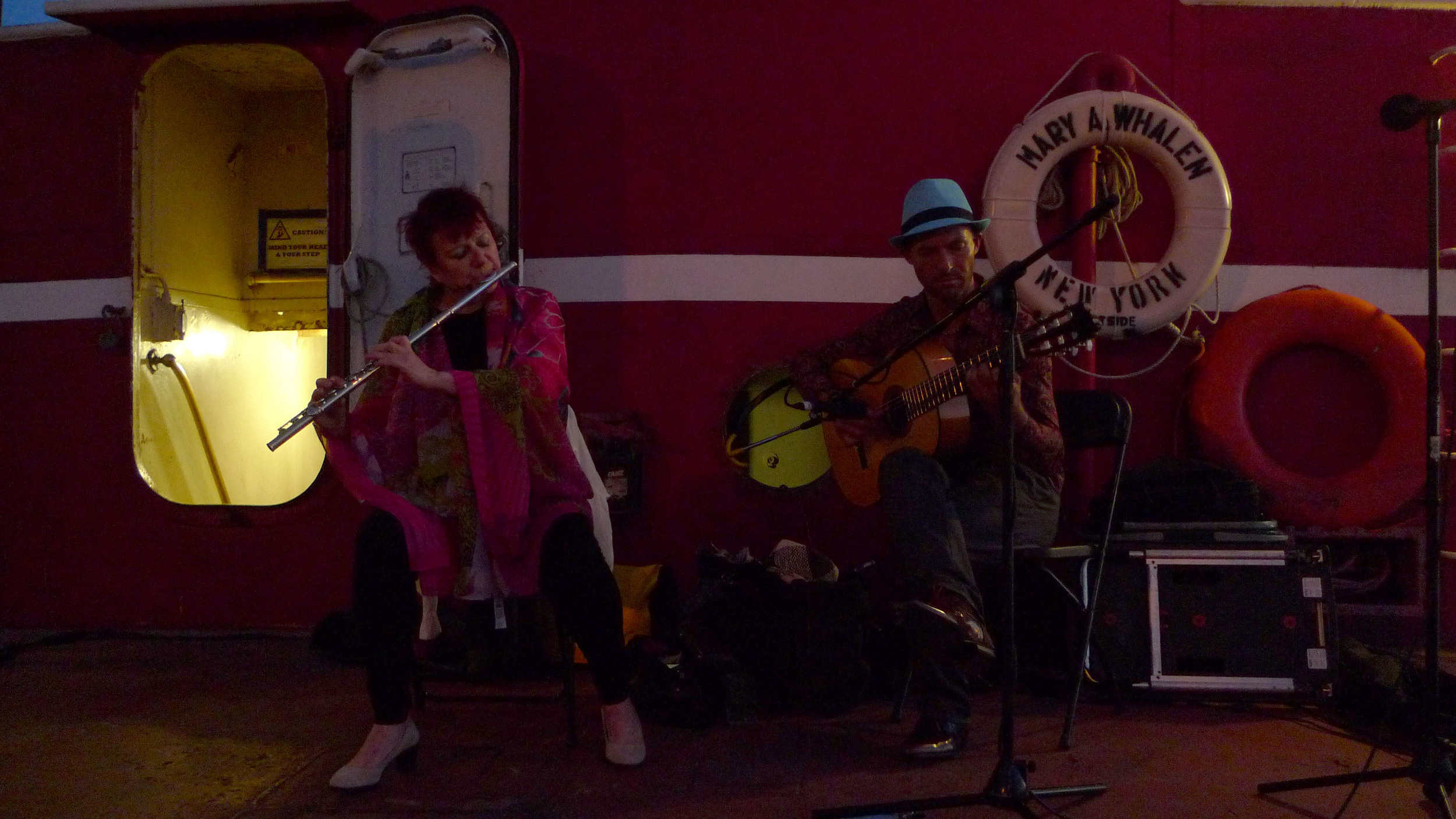
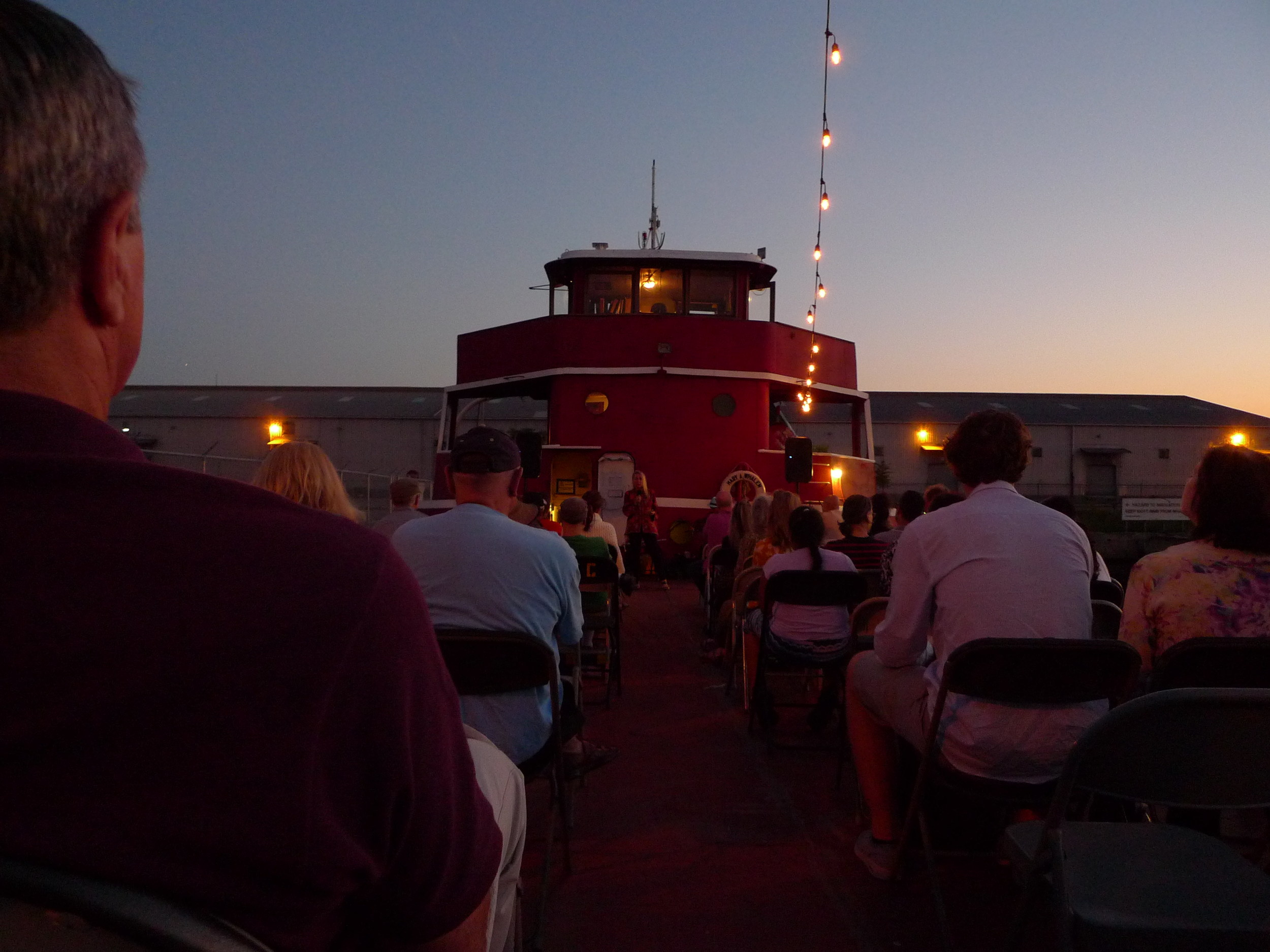
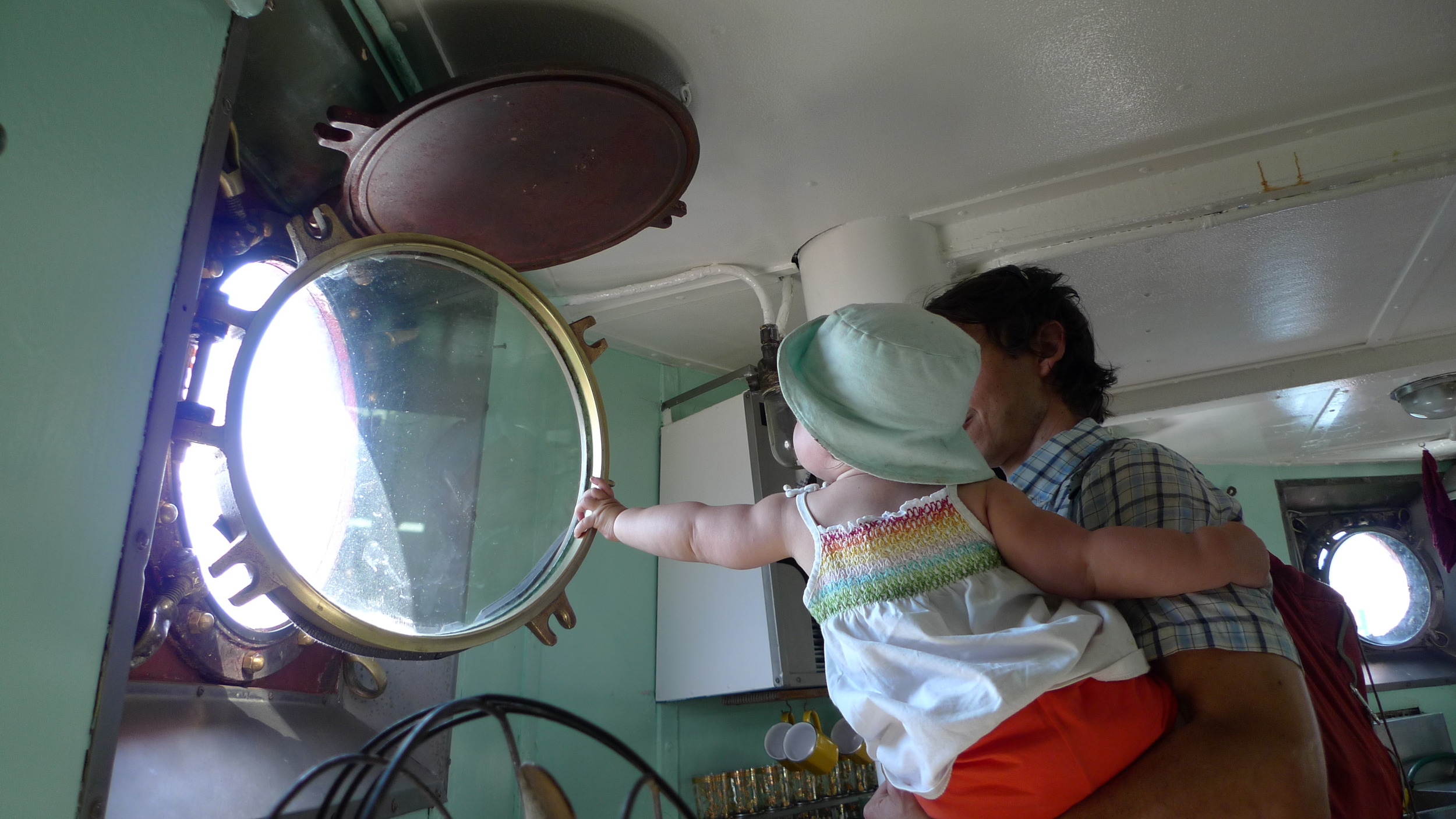
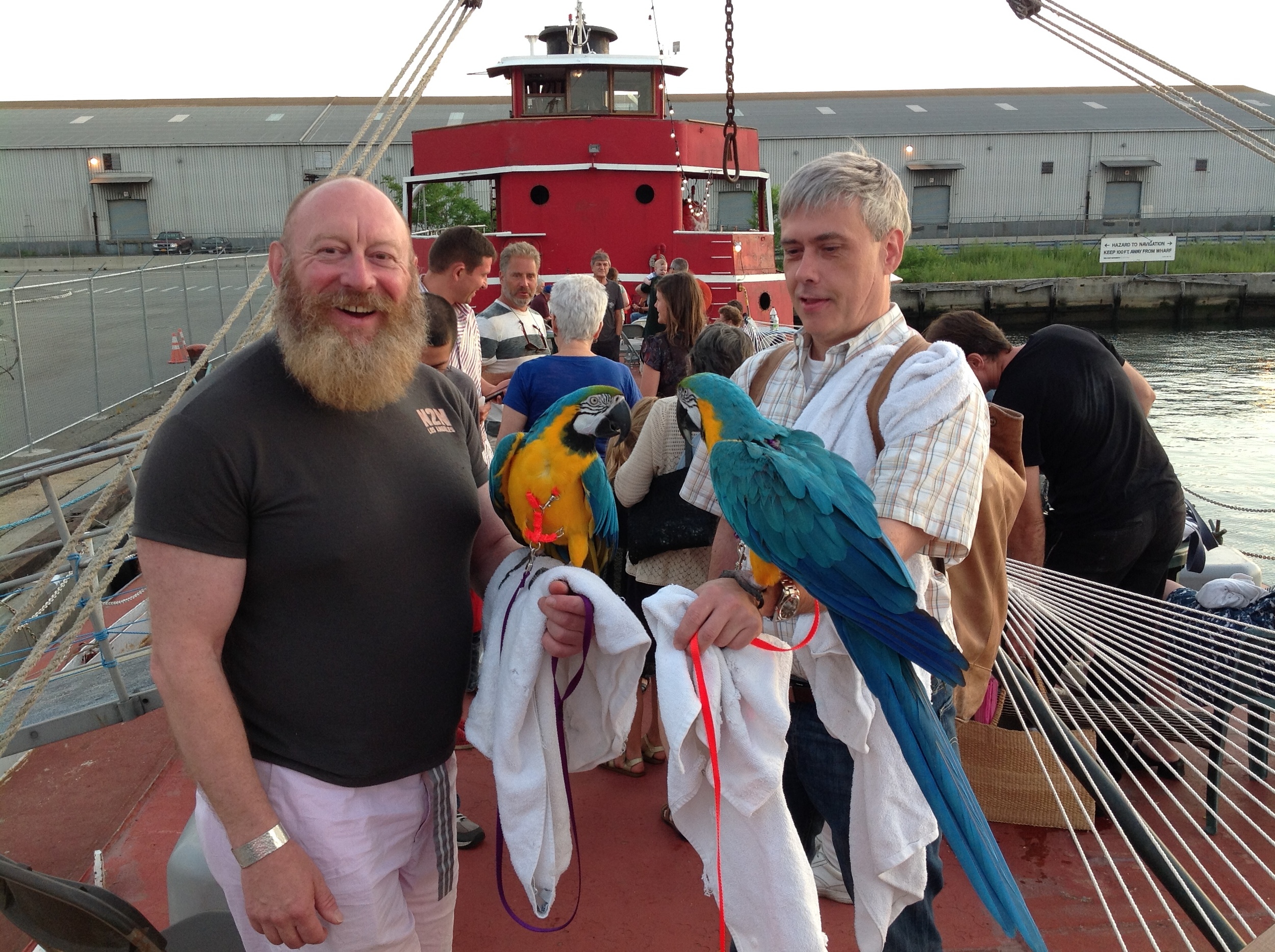

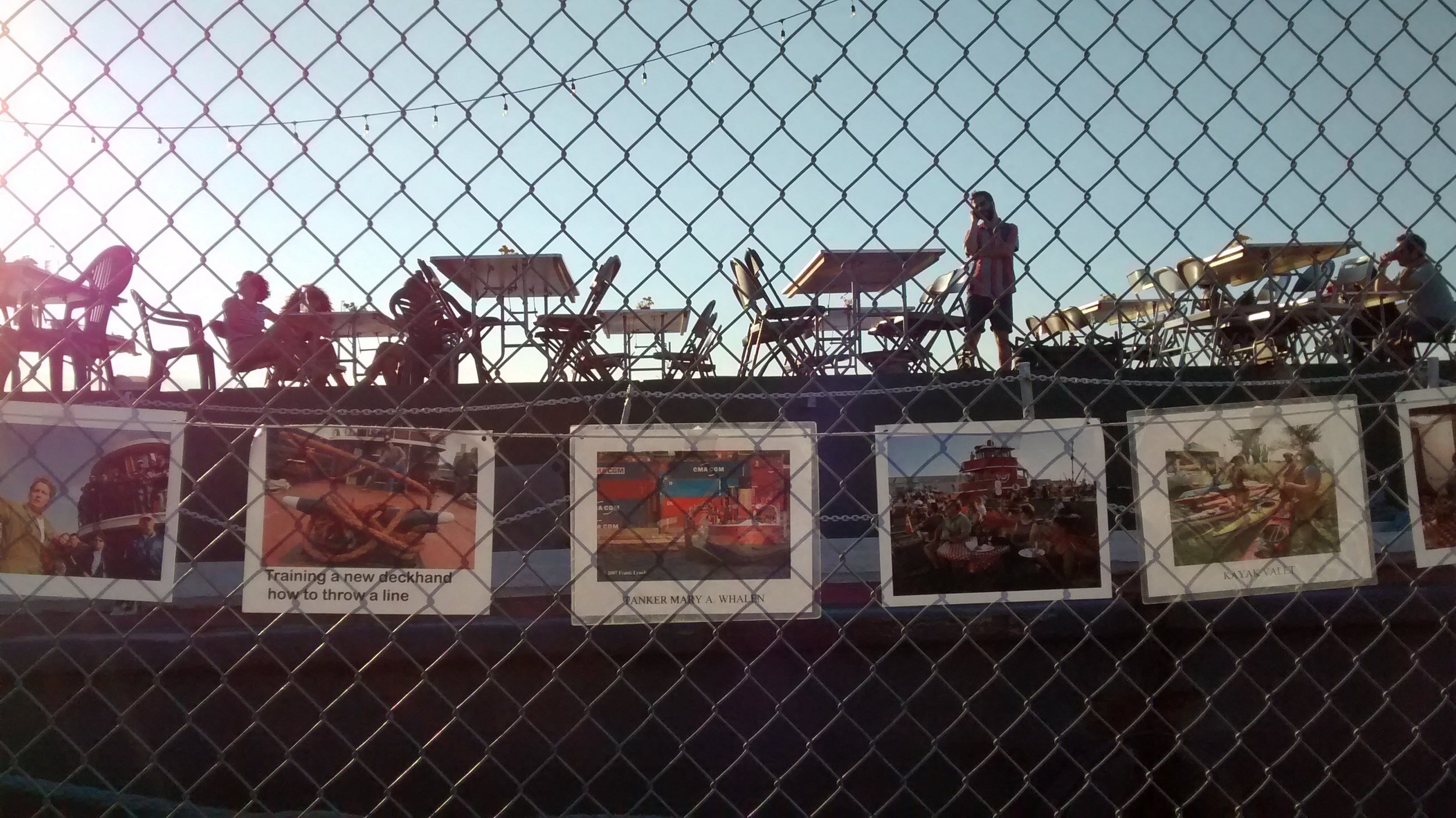
We secured $20,000 in funding from Councilman Carlos Menchaca to support our Red Hook WaterStories cultural tourism, placemaking and resiliency project. We were invited to join a historic ship flotilla that celebrated Cunard's 175th anniversary and got community members in the parade via our partner, the historic tug CORNELL. We curated and ran a great POW! weekend with TankerTours, TankerTime and gifted flamenco jazz musicians who have offered to make this an annual event. We produced a distinctive multimedia history night with Norwegian Red Hook WaterStories with bluegrass musicians from Norway, history speakers, and vintage video. Out shipcat Chiclet has become an attraction, with a growing fan club of regulars who come by to see her.
Volunteers repainted three cabins! Thank you, volunteers! Three summer interns from WHSAD did enormous work restoring the teak rail around the wheelhouse. The painters' union District Council 9 will repaint the exterior as a training excercise with paint donated by International Paint. DC9 scoped out the job, did some prep work, and laid plans for painting in 2016.
History runs through so many of our programs: all events on the ship, programs such as our Norwegian Red Hook WaterStories night, info content we share on our Facebook and Twitter, our blogposts such the one about the important sale of slave ERIE ship in Atlantic Basin which marked an important step in the end of slavery in the USA. In 2015, we added considerably to Mary A. Whalen history: more former crew members found us (thanks to our new home): Engineer Bill Siebert who works on a Vane tug and retired, 86-year old, former relief captain Thomas J. Smith. Captain Smith donated his maritime papers to us, and we have taped hours of interviews with him. A big boost in the history department was the visit by Scott Gellatly and his wife Pat. They ran a waterborne fuel transportation company years ago and almost bought the MARY. The Gellatlys donated photos, recorded hours of interview and brought along retired engineer Bryan Sinram, another trove of history, who had worked for Eklof, the company that ran the MARY WHALEN for years. Walter Barschow donated the folk painting of the MARY aground in the slide show above and gave us leads on Red Hook WaterStories about his family that ran a scrap yard for decades, founded by his German immigrant grandmother. Karen Dyrland and John Weaver donated another large cache of photos, letters and documents from Alf Dyrland, Captain of the MARY from 1962-1978. And, our home, the historic tanker MARY A. WHALEN turned 77!
PortSide continued to inspire filmmakers, painters and multi-media artists. Most find us because they can now see us. The MARY A. WHALEN is visible from our new friends and partners Pioneer Works which leads to a steady stream of artists coming to brainstorm, photograph, get ideas, one even collects salt water for a printing project. We gave the title to the documentary film BLUESPACE and appeared in it. We invited painter Jim Ebersole to memorialize our final week in the Red Hook Containerport.
This important work does not generate inspiring, cuddly or sexy photos. It involves a slew of emails and hundreds of conversations that advance our vision for bringing change to NYC's waterfront. Some highlights: Our President Carolina Salguero was appointed to the Sunset Park Task Force whose first task was to advise the EDC on creating an RFP for SBMT. How's that for alphabet soup! The Task Force continues to meet to shape the Sunset Park waterfront and industrial waterfront district. PortSide provided info and advice on the siting of a Citywide ferry stop in Red Hook. We are engaged with the ongoing work of Red Hook's NY Rising committee. We had a photogenic policy gig by being a stop on Alex Washburn's OHNY Resiliency bike tour.
Getting our new home in Atlantic Basin, has provided PortSide NewYork with much needed stability and allowed us to turn energies to growing PortSide's capacity. We grew the team with 2 board members and 4 advisory board members. We completed the long slog of paperwork of a FEMA Sandy Alternate Project application, along with other important funding applications. We were awarded $20,000 by Councilman Carlos Menchaca to support our Red Hook WaterStories project. In Late October, PortSide launched a year-long growth campaign #GetOnBoard. In December, we were awarded a competitive Regional Economic Development Council grant of $49,500 via the New York State Council on the Arts with the support of Governor Andrew M. Cuomo and the New York State Legislature. We scored new major sponsors in the Weather Channel and International Paint. There is strong growth in the number of entities reaching out to get involved: we have heard from college community service programs, schools, teachers and individuals.
Please donate now and support our momentum!
PortSide NewYork won a White House “Champions of Change” award in April 2013 for our hurricane Sandy recovery work and honors shortly thereafter from the New York State Senate.
A huge part of our Sandy recovery work depended on the generous actions of three people PortSide honored at our fundraiser just before the two-year anniversary of the storm on October 28, 2014 at Hometown Bar-B-Que. More on them below.
Blogpost about the fundraiser in general
Blogpost about our special good neighbor award to IKEA
Victoria Hagman is principal of Realty Collective. So much of PortSide's recovery work after saving the MARY A. WHALEN was enabled by her generosity. Despite Victoria's home having been flooded along with the basement contents of her Red Hook business location, Victoria, without hesitation and no strings attached, allowed PortSide to use the 351 Van Brunt storefront as an aid station.
That offer included free electricity, heat, (and telephone and internet once those were back up.) This became Red Hook’s first small business recovery center, before the location at IKEA, hosting different groups. The storefront housed a gallery at that time, so PortSide had a stylish aid station, and the fact that the gallery was there is a testament to the trust that Victoria offered in making the space available. Several Sandy survivors commented that the white gallery space and bright art was uplifting.
Victoria helped set up a meeting for homeowners to get resilient rebuilding advice from Jim Garrison an architect from Pratt Institute and more. She continues to do work for Red Hook Sandy recovery and resiliency efforts via multiple groups by participating in NY Rising, in special events promoting red hook, a zoning working, being on the CB6 board and the Gowanus CAG, Ready Red Hook emergency response plan… Safe to say, that if there’s some group working to improve Red Hook, Victoria’s probably in it.
James Hill (left) of the Brooklyn Chamber of Commerce presents the award to electrician Danny Schneider
Danny Schneider, the principal of Schneider Electrical Contracting in Park Slope, walked into PortSide's Sandy aid center "351" within days of the storm and offered free electrical services. He had heard through his wife's Facebook page that electricians were needed in Red Hook.
PortSide offered to coordinate his work, and word of the “electrician sign-up sheet” at 351 spread like wildfire in Red Hook. PortSide amalgamated requests by phone, email and text and conveyed them to Danny, who worked off the sign-up sheet.
Danny reports that he inspected and certified sixty buildings (which means many more families than sixty) for free, and repaired some two dozen for the cost of parts. When electrical parts were getting hard to source, he passed that info to PortSide who began hunting for parts in bulk. He battled hours of traffic each day to get to Red Hook; and in the middle of all that, his license was up for renewal so he battled traffic and lines downtown to get that renewed, and came back to help. He also did volunteer electrical repair in the Rockaways.
Danny Schneider also speaks at the end of the video with honoree Victoria Hagman.
Peter Rothernberg (lefti holding his award, and Carolina Salguero (right)
Peter Rothenberg is PortSide’s Historian and Curator. His recovery work includes prevention, restoration of historic artifacts and direct service to Red Hook Sandy survivors, as well as reassuring ministrations to ship cat Chiclet. on our ship during the storm. See video of Peter receiving his award here.
Within the crew of rambunctious wits that is PortSide NewYork, Peter is a quiet, private worker and just the kind of steady guy you want around when a storm is coming and things are going to hit the fan.
Peter helped PortSide prepare the tanker Mary Whalen for Sandy for four and a half days, and he rode out the storm on the ship with PortSide Director Carolina Salguero and Chiclet.
Peter came armed with foul weather gear and four gallons of corn chowder left over from a Brooklyn Botanic Gardens event (after three days of corn chowder, that taste will forever be associated in our minds with the hurricane). He also came armed with a tender heart for Chiclet who had that knowledge animals have that something bad is coming and washed herself steadily for many hours. Peter made Chiclet a tuffet of pillows so she could see out the tankerman’s cabin porthole
During the storm, Peter joined Carolina working outside easing lines… putting a chimney cap on the stove… putting another line around the tarp covering the wheelhouse windows… and the epic job of tying together every dockline not already in use and dragging that through the water to the pier 265’ to the north. That line was to prevent the MARY A.WHALEN from floating up onto the pier, and maybe rolling or impaling herself on a bollard or wreaking any havoc. As the surge waters rose around him, Peter crawled on hands and knees across the jersey barriers along the bulkhead back to the ship.
After the storm. Peter helped rinse out and dry our flooded electrical transformer (which we are still using); and when he found out that Carolina Salguero had forgotten to get our collection of historic documents out of the shed, he set to drying out the collection. Within hours, he had every horizontal surface aboard the tanker covered in wet historic papers, interleaved with whatever we had at hand (sheets, towels, paper towels, wax paper). The stevedores' lounge in the shed was also covered with this project for several weeks.
Peter and Carolina came ashore and set up and ran the aid station at 351 Van Brunt for several days until Dan Goncharoff could make it in from Manhattan to join us. Peter spent much of his time at 351 helping people who did not know how to use computers apply for aid and do other work on the internet.
2022 update: PortSide helped get Red Hook’s Verizon internet back up by calling John Liantonio of the Port Authority. His prior job was to be the cellphone industry rep in the northeast. Carolina Salguero called him and asked him if he could reach key people at Verizon as we had set up an aid station thinking there was internet, and there was none, and Red Hook had been hammered by Sandy. The only internet we were offering was our modem that Peter hung up in a tree out front! Liantonio made the call, Verizon got on it, and Verizon service was up in less than 48 hours! Liantonio did not want this story told at the time.
At our October 28, 2014 Fundraiser "Resiliency is our HOOK," PortSide went off script, as we are wont to do, and gave the Red Hook IKEA store a surprise award.
We presented IKEA with a "PortSide Good Neighbor Award for Sandy Recovery Work" in recognition of the varied, inventive and generous aid they provided for over a year.
We gave this award because we think IKEA deserves recognition at the community level for what their Brooklyn store did for Red Hook after Sandy.
We also gave IKEA the award because we are an educational organization, and we think there are some important lessons in the IKEA Sandy story.
1) IKEA was able to help because they built a resilient building in the first place with the store set high up on a second floor (the garage beneath the store is flood-able space) with elevated electricity and mechanicals. The rectangle of the building was also angled so that a corner faced the water so that it could part waves as does the bow of a ship. Given the surge in resiliency planning talk after Sandy, we think people should be looking at a design that worked and a company that thought to build that way nine years before Sandy.
2) The absence of reporting about IKEA’s large-scale, diverse and prolonged recovery work says something about the media. It shows how reporting clusters around themes, how reporting can be an echo chamber reiterating earlier stories. That a big box store could turn its cafeteria into and aid center and NOT have that generate a single feature story is a remarkable absence. The Fourth Estate can help the discussions of what worked and failed in the recovery period and is going to foster intelligent discussions of resiliency planning, so we ask them to look more closely.
3) Looking to the future, it is important when making recovery and resiliency plans to understand who really did what in the wake of Sandy. We encourage everyone (the Red Hook grassroots level, the consultant/planner/think tank contingent, elected officials and the media) to think about what gaps in reporting about Sandy may exist and research those gaps. PortSide raised awareness of some knowledge gaps in the article “PortSide NewYork & other hidden Sandy Stories” that we wrote at the invitation of the local paper, the Red Hook Star Revue.
IKEA Brooklyn donated furniture to over 25 small businesses.
IKEA Brooklyn donated products directly to local non profits.
IKEA opened its Red Hook doors to National Disaster Organizations (FEMA & SBA, the Brooklyn Chamber of Commerce and others which used half of the cafeteria and other spaces for their operations.
IKEA Brooklyn worked with Tunnel2Towers who brought about 16 box trucks full of donations for their co-workers and Red Hook neighbors for two weeks.
IKEA Brooklyn held a hiring event for displaced workers as a result of Sandy, offering temp work until their home businesses were back on their feet.
Additional work occurred at IKEA Elizabeth, Paramus, & Long Island with each store each working with their local communities.
IKEA provided $250,000 so that GlobalGreen could implement the “Solar for Sandy program” which installed solar power in the Red Hook Rec Center, so Red Hook has one off-the-grid community emergency center. The ribbon cutting was October 23, 2013 just before the first Sandy anniversary.
IKEA Brooklyn subsidized free Red Hook Summer Ferry in 2013 and 2014.
IKEA Brooklyn provided great support for their co-workers:
They brought in 3 counselors to help co-workers cope with the situation.
IKEA converted its large conference room into a makeshift shelter for co-workers and their families.
IKEA US organized a co-worker to co-worker donation program to help those IKEA co-workers who lost their homes or personal belongings.
IKEA received donations from other IKEA stores to give to our co-workers & their families (The store in Virginia sent a truck full of donations, driven up by two of their co-workers).
IKEA US donated over $500,000 in products for the NY/NJ area to disaster relief via the Red Cross.
IKEA donated furniture to firehouses, senior centers, & public libraries after Sandy
IKEA donated home furnishing to a Family Head Start/Early Learning facility in Brooklyn affected by Hurricane Sandy as part of the Life Improvement Project.
IKEA together with Tunnel2Towers:
donated furnishings for those in need in Staten Island and Brooklyn. Beds, mattresses, dining tables and chairs, chest of drawers, sofas. Value approximately $300K at retail dollars.
Product to be delivered to Staten Island and Gerritsen Beach locations.
Donations benefited between 500 to 1000 families in need.
IKEA teamed up with Save the Children and UPS to help refurnish 39 early childhood development centers in New York and New Jersey hit by Hurricane Sandy.
IKEA donated more than $100,000 worth of items, including bookcases, children's tables and chairs, cribs, desks and blankets to devastated child care centers Save the Children is helping to restore, as well as to the charity's Brooklyn field office. UPS is donating delivery services.
IKEA held special Sandy Recovery marketing events:
20% off Kitchens in January to help people rebuild
IKEA Brooklyn discounted moving boxes (Samla) in the months after Sandy
Dear Mariners (ones on contemporary ships and historic ones) as we build up to the 2-year anniversary of hurricane Sandy, we invite you to tell you Sandy stories and share your photos here. We ask you to join us in an educational project.
A goal of PortSide NewYork is to bring the community ashore and community ashore closer together. Sharing Sandy stories is one important way to do that. We have found that most people ashore in NYC don’t know the mariners’ Sandy story, from prevention, to riding out the storm, to damages incurred, to recovery work -- usually recovery work while being damaged from Sandy.
In the way that PortSide told the mariners’ response to 9/11 in an exhibit, we would like to do that with Sandy, and we’d like to start that project here.
We believe that resiliency planning in NYC should involve hearing from the people who build the bulkheads and piers (and who will build any of the sea walls being proposed), marine salvors and equipment suppliers who pump the flooded tunnels, the crew and companies who move the fuel everyone was so desperate to have after Sandy, who clear the channels of debris so imports could arrive by ship, who build and run the emergency ferries, and companies that use boats like dinner boats in emergency response ways, etc.
We also believe mariners can have an important role in preparing communities for floods by helping teach awareness of marine weather, by bringing coastal living skills to New Yorkers living at the water's edge who lack those skills.
There are coastal parts of NYC where communities retain what were traditional coastal skills in abundance, the Rockaways, City Island, parts of Staten Island, where bayman, watermen, boatmen (and women) live, work and play; but large parts of NYC’s waterfront are now populated by people who have little sense of the water along which they live.
PortSide has designed some programs to share knowledge of the water with such people, and we’d like to see if we could kick off that conversation here.
What echoes in our ears is what we heard so often in the Sandy aid center we ran in Red Hook when people explained why they did not prep for Sandy either by evacuating or executing protective measures “they warned us about Irene, and nothing happened.”
This request is also on our two Facebook pages (Mary A. Whalen and PortSide NewYork) for people who would rather share there.
Photo and caption from article today in New York Times: Saratoga Ballfields, Brownsville, Brooklyn. Photo by Ruth Fremson/The New York Times
Park Equity News from Gotham Gazette
Park Equity News from New York Times
Valentino Park Comfort Station proposed Parks Department plan. This became so large, in part, due to FEMA requirements that a new building in coastal flood zone be elevated.
Dear Red Hook:
Thinking of the Valentino Park and Coffey Park discussions, above is info about citywide discussions about #parkequity to get funding to underserved neighborhoods. Mayor Bill de Blasio will announce a new plan today with $130MM in funding to go to 35 parks.
This is encouraging news in and of itself (we support more going to communities that have less) and seems like a good time to bring to citywide level one of the issues that our Valentino Comfort station has brought up, eg, how to keep costs down.
$130MM will not go far if 4 toilet stalls cost $2.4MM.
Let's find ways to engage constructively in a citywide discussion about how to improve parks for all. Better, cheaper, smaller potties for us could be the start of something bigger for all. All word play intended.
It would be good for Red Hook to bear in mind, that though many feel this community was slighted for years, by now Red Hook has revitalized so much we are NOT as underserved as places like Brownsville are.
Thanks to NYS Senator Daniel Squadron for his work on #parkequity and to Councilman Carlos Menchaca for bringing the New York City Department of Parks & Recreation to the community table for meetings about waterfront parks in Red Hook and Sunset Park.
The toilet was finally installed! This took TEN YEARS!
The Valentino Park planning uses start with other topics covered at 9/5/14, and then the focus becomes the huge, expensive “comfort station” proposed by the Parks Department covered in blogposts 9/24/14, 9/25/14, and this one.
PortSide stayed on this matter for 10 years!
PortSide’s involvement with this issue started at the request of then Councilman Carlos Menchace in 2014. We brought up the toilet issue with the staff of Councilmember Alexa Aviles after she was elected, emailed and called Parks and DOT (the toilet was moved to be a the sidewalk one, making it a DOT space and project, not a Parks one). We pushed when Valentino got crowded during the start of pandemic, when a NYC #toiletequity campaign started, and again when other parks were selected for pilot toilet projects.
November 24, 2024 update
During the Barnacle Parade, we spot that a sidewalk toilet is being installed on Ferris Street opposite Hoek Pizza in early November. We have been emailing with the DOT and will share info about toilet opening date. We pushed for this toilet for years after the public planning process ended.
February 27, 2023 update
At the 4/20/22 ballfields re-opening, we were told by a reliable City agency source that there was a lawsuit between Cemusa (the toilet vendor) and NYC; and until that was resolved, no such toilet was going anywhere in NYC. On 2/27/23, we learn from an article in THE CITY that NYC will do a test program with Portland Loo toilets of the kind that Anne Griepenberg of Red Hook proposed in 2014 during the early stages of the Valentino Park toilet saga; but Red Hook will not be getting one of those test program Portland Loos, even though use of Valentino Park surged during the pandemic. No #parkequity for Red Hook.
April 2, 2021 update
Still no toilet despite one being approved in 2018 (see history below). On a regular basis over the years, PortSide asks multiple government about the approved toilet. We ask since we advocate for our local waterfront park spaces, AND because we propose replacing the exterior advertising on the toilet with educational and safety info such as we planned for our BoatBox proposal that fizzled into delays by changing elected officials, Parks commissioners and more. Our last round on the toilet was July 2019, when we forwarded a thread of emails to the DOT, copying supportive staff from Councilman Carlos Menchaca’s office. We got the following response:
From: Frumin, Rachel [mailto:rfrumin@dot.nyc.gov]
Sent: Monday, July 01, 2019 11:31 AM
To: Budelman, Brandon; Carolina Salguero
Cc: Branch, Leroy; Widdison, Renae; Craven, Michelle
Subject: RE: PortSide NewYork request to put info on Valentino Park Street toilet
Hi all,
The approved project is delayed due to DEP issues that requested an agreement letter between DOT and Parks on the site plan. That is in process. Also, the existing fence is not a standard one that we can easily procure. Instead, the fence is custom that was commissioned by EDC. To move the fence to accommodate an APT require reconfiguration of the fence work to maintain the flow of the curvy lines in the middle as well as to find a fabricator to build and install the fence. I’m working on this and it is taking some time.
Rachel
Rachel Frumin
Director of Concessions and Franchises
NYC Department of Transportation
55 Water Street, 9th Floor
New York, NY 10041
rfrumin@dot.nyc.gov
646-586-5787
We followed up and said that we could introduce them to lots of local metal fabricators who could replicate the fence, or make new. Resounding silence since. We are sure users of the park care more about getting a toilet than having the fence section match - though surely the amazing artisans of Red Hook could match the original fence.
January 2018 update
DOT has approved a sidewalk toilet. Red Hook, we have been heard! Remember all those meetings about a big, expensive "comfort station" proposed for our charming waterfront park Valentino Park? That concept was defeated, and a small, sidewalk toilet is coming via the DOT. Thanks to everyone for participating in public meetings, on-line discussions with us, and other modes. Community action worked! A special shout out to Anne Griepenburgwho researched the Portland Loo which presented an alternative that appealed to many and may have swung government decision around to that kind of solution.
Toilet Party any one? It has the great acronym of TP.
We hear that there is a spring installation expected, but we are still waiting on confirmation.
Next Red Hook meeting about Valentino Park Comfort Station: Note, this is a change from the originally announced date of 10/8!
People for Red Hook Public Parks (PRHPP) set up this meeting. Here is their REVISED announcement PDF
Here is Parks Department proposed comfort station
Report on Meeting #1: 9/4/14 Meeting with Carlos Menchaca & Parks at Red Hook library
Background info: Parks Dept. proposed comfort station & the process
Report on Meeting #2: 9/24/14 PRHPP meeting at 351 Van Brunt for community members only.
People for Red Hook Public Parks and City Councilman Carlos Menchaca will be holding a community meeting on Wed. October 8th at 7pm at P.S. 15, The Daly School on Sullivan Street, between Van Brunt and Richards St. in Red Hook. The meeting is the latest in a series of meetings regarding the proposed NYC New York City Department of Parks & Recreation comfort station for Valentino Park.
The Red Hook community has expressed serious concerns about this project: cost, its size location and necessity.
At a cost of $2.5 million dollars, the cost to taxpayers for this project will be over $4000 per square foot. Construction costs for a luxury condominium in Manhattan are $500 per square foot.
The proposed location, Valentino Pier Park, is a quiet community gem, treasured by the neighborhood. The proposed building will cut the park in half and occupy a large portion of open green space.
With a change in city administration, the Red Hook community is counting on a reversal of the top--‐down management style of previous administrations. In order to protect our parks and our neighborhood, we need to bring the people who make decisions together with the people those decisions impact.
So please come to the meeting and bring a friend. We wish to avoid acrimony and work towards a positive relationship between community and administration, so bring your ideas and yourself!
Support our fundraiser on Tuesday 10/28/14 “Resiliency is our HOOK.” Buy a ticket. Become a sponsor. Join the Host Committee and help sell tickets before the event. It will be a fun event with the rollicking Dixieland jazz of the Red Hook Ramblers and the great food and casual ambiance of Hometown Bar-B-Que restaurant. We greatly appreciate your support! As do the people and businesses who benefit from our resiliency work!
Amended 11/12/14 to include the following link and background about Eymund Diegel:
For related info, see our blogpost that includes Jim McMahon's Sandy flood map of Red Hook and info on how to assess your flood risk in future storms."
More info about Eymund Diegel:
Original post:
To further support flood prevention planning in Red Hook, we offer the following information.
The data and points of view in the following bullet points are courtesy of Eymund Diegel:
Brooklyn Greenway Stormwater Study for West Street in Greenpoint, Brooklyn includes ideas to consider
4/25/12 Waterfronts Committee Meeting. Photo courtesy of www.JimmyVanBramer.com
On January 22, 2014, the City Council announced its committee and committee members. This is PortSide NewYork’s guide to the City Council and the waterfront.
The Council has a committee dedicated to the waterfront; and, at times, waterfront matters may be taken up in hearings jointly run by committees such as Land Use, Transportation or Sanitation and Solid Waste. There is a new committee Recovery & Resiliency which will surely deal with waterfront matters.
The size of the committees says something about NYC priorities. Waterfronts has only five members; Land Use has twenty-one members and three subcommittees.
The Committee on Waterfronts consists of five members, headed by Deborah Rose. Her district includes this port’s vital stretch of working waterfront along Staten Island’s Richmond Terrace, including Mariners Harbor and the Howland Hook Marine Terminal.
The four other committee members are Chaim M. Deutsch representing the waterfront of Sheepshead Bay/Manhattan Beach/Brighton Beach, Daniel R. Garodnick representing the waterfront of Manhattan’s East Side, Corey Johnson representing the waterfront of Canal Street to West 59th Street Manhattan, and Paul Vallone representing the waterfront of North East Queens.
According to their official Council biographies, Chaim Deutsch is the only one listing some waterfront experience which was hurricane Sandy. He mobilized community-based volunteers and coordinated with the Flatbush Shomrim to help evacuate residents, he helped in actual evacuations; coordinating with government and aid organizations, and helped distribute aid.
The City Council has a Progressive Caucus of which the Council Speaker Melissa Mark-Viverito is a member. The Progressive Caucus released a 13 point plan for change. We were pleased to see “Waterfront” listed in point # 3 "Smart Economic Development- Reduce inequality through smart and accountable economic development." Click on that to find:
“Strengthen the city’s core blue-collar and middle-income sectors by focusing subsidies in diversified economic clusters. Invest in more balanced, innovative, mixed-use development to meet a broader range of goals developed with community stakeholders, such as preserving and strengthening manufacturing and small businesses, creative use of waterfronts, and the community infrastructure needed to sustain growth and share its benefits (e.g. schools, child care, open space, etc.)”
Their "creative use of waterfronts" certainly describes PortSide NewYork! We hope this means that the Progressive Caucus will embrace the PortSide cause and help us speedily find a home, and we hope that we can work with the Progressive Caucus and the Waterfronts committee and share our waterfront expertise and further our goal of bringing NYC's Sixth Borough BlueSpace to life!
Gotham Gazette's article on City Council committee appointments includes links at the bottom with summaries of the major activities of each committee last session, predictions about its upcoming role, and stipends paid to the councilmembers.
The first "hearing" of the Waterfronts committee is a tour of Brooklyn Bridge Park Friday, 2/28/14 at 10am. These meetings are open to the public.
Red Hook NY Rising Community Reconstruction Program
Open House
Realty Collective, 351 Van Brunt St
Sat 2/22 & Sun 2/23 11am – 6pm
Where you are going: 351 Van Brunt while it was PortSide's Sandy aid center November 2012
Only a few months of planning remain in the Red Hook NY Rising Community Reconstruction Program and the Committee is excited to engage the Red Hook community in the critical final phase of the program. The upcoming public meeting will be an important opportunity to gather community input on the top Priority Projects that may be recommended for funding with Red Hook’s $3M CDBG-DR allocation. We encourage everyone to attend this event and have your voice heard. At this event the Red Hook Committee will share ideas that its members have heard from you to date and answer questions you may have about the program and possible resiliency projects. Details for the event are on the attached flyer and as follows:
Experts will be on hand to discuss specific topics on Saturday and Sunday at the following times:
12pm-1pm: Infrastructure & Coastal Resiliency
1pm-2pm: Social Resiliency & Economic Development
Red Hook Resiliency Innovations event Sat 2/22, 3-6pm
Guest speakers to include: HUD Rebuild by Design, Brooklyn Greenway Initiative, Fifth Avenue Committee (FAC) and Architecture for Humanity, and others.
We also have a few newsworthy pieces from the past few months to share:
We hope to see everyone at the upcoming public event.
As always, thank you for your continued engagement in the Red Hook NY Rising Community Reconstruction Program.
Sincerely,
NY Rising Red Hook Planning Committee & Committee Co-Chairs
Gita Nandan
Ian Marvy
Like us on Facebook: https://www.facebook.com/nystormrecovery
Follow us on Twitter: https://twitter.com/NYStormRecovery
Red Hook "Sandy Helpdesk" Feb 8-10, 2014 - pick a time slot on one of the three days and free resiliency, rebuilding advice from architects and building trades professionals. See page 2 of flyer
Feb 8-10, 2014 Asesora acerca de códigos de construcción zonificación y diseño en vecindarios afectados por Sandy para propietarios de edificios mas Informacion
Red Hook resiliency workshop Thurs 2/6/14 7pm at Hometown BBQ "to talk more generally about building innovative resiliency approaches people are developing in Red Hook."
Volunteer building trades professionals wanted in general (not just for Sandy Helpdesk). Please get involved!
This information comes from an email from Pratt which we copy below.
Background info
Pratt Center is working with Architecture for Humanity, Enterprise, the NY chapter of the AIA, and also with City agencies and with local partners (Margert Community Development Corp. in Rockaway; Fifth Avenue Committee and Red Hook Volunteers in Red Hook) to pilot the Sandy Design Helpdesk. The Helpdesk offers free consultations with architects and other professionals to residents, business owners, and building owners on Sandy-related design, code, and zoning issues – we’re also adding other experts based on what we hear from local partners, so in Red Hook there will also be insurance and mortgage advisors available.
Obviously with a one-time consult, the volunteer architects can’t provide much more than suggested design solutions to code/zoning/insurance problems, and maybe a freehand sketch – but we’re finding that this can be pretty helpful, especially for people who aren’t eligible for major assistance like Build it Back, or who are trying to figure out their options while they wait to find out where they stand.
So the Red Hook Help Desk will be February 8-10 (a flyer is attached)– but in Red Hook, there’s been so much thinking done (about the many local and challenging problems) that we are adding a workshop that will take place before the Help Desk, to talk more generally about building innovative resiliency approaches people are developing in Red Hook. The workshop event will take place on Thursday Feb 6th, at 7pm at HomeTown.
We’re also interested in adding to our volunteer pool. Volunteers get free training from NYC Department of Buildings and Department of City Planning staff on post-Sandy zoning and building code changes (and probably continuing education credits via the AIA); they are also covered by Architecture for Humanity’s liability insurance and it’s pretty-well-tested waiver. People who volunteered in Rockaway last October found it to be informative and rewarding, so if you’re willing to forward the Volunteer poster along to anyone in your professional networks, we’d much appreciate that too.
Joan Byron
Director of Policy
Pratt Center for Community Development
718-636-3468 (office)
www.prattcenter.net